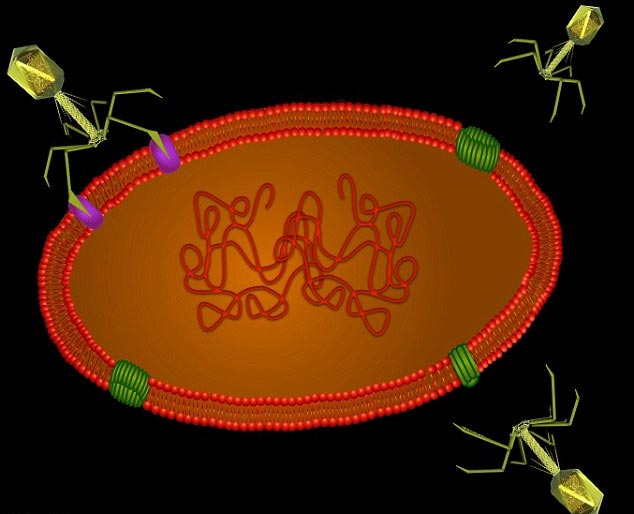'Alien' virus on the seabed
Efforts to find aliens should probably start down the ocean's waves, instead of outside our atmosphere, after scientists discover a new virus, Extremely strange hidden deep in the sea.
Detecting a new, strange virus at the bottom of the sea
While studying bacterial species growing on fossil fuel deposits deep inside the Earth, collectively known as archae , experts from the University of California Santa Barbara (USA) discovered a New viruses poison them.
The team now believes that it is these viruses that actually hold secrets , which allow archae bacteria to adapt to some of the harshest environments on Earth. This is because active virus causes one of its own genes to mutate, helping it develop new ways to deal with the ecosystem it resides.

The image simulates how the new virus changes "mooring tip" (purple) to infect archae bacteria.(Photo: Daily Mail)
Scientists have previously speculated that the discovery of archae bacteria deep inside the Earth's crust increases the prospect of finding life on other planets . They seem to be able to find such "extraterrestrial" viruses right now in the archae bacteria.
Dr. David Valentine, a land researcher at the University of California Santa Barbara and co-author of the new study, said: "Our research has revealed mechanisms through which viruses and archaea bacteria can adapt in harsh environments behind the seabed ".
According to a research report in Nature Communications, Dr Valentine and colleagues discovered a strange virus while exploring trenches of methane spray deeper than 850 meters below the surface of the sea, in the Santa Monica Basin in the ocean. California. When screening the genome of methane-eating bacteria, extracted from seabed sediments and reared in the laboratory, they found genetic traces of the new virus.
When testing other samples taken from around the world, the team found similar traces in bacteria from South Uy and other places along the California coast of the United States. This evidence implies that the new virus is distributed around the globe, in places where methane is located deep in the sea.
Dr. Valentine and colleagues also discovered that a small genetic element, called "retroelement," produces diversity " that can boost mutations in a certain part of the virus's own genome.
Dr. Blair Paul, co-author of the study, explains: "The goal of guided mutations - the ends of the virus that make the first contact when attacking a cell - is the same. However, it is possible. These mutant ends are a countermeasure against the cell's defense mechanism, a move similar to the molecular arms race. "
The researchers also found similar mutant guide elements in the seabed archae bacteria themselves. This discovery implies that life on the bottom of the sea and in rocks deep below the surface can be more diverse than our thoughts for a long time.
- Canada started drawing seabed maps around the North Pole
- Check out the most dangerous viruses on the planet
- Detecting alien creatures under the seabed of Indonesia
- Summary of 'hot' news on April 2
- Seabeds on the oceans are literally melted and what is the reason?
- HIV virus is no longer as dangerous as before
- Alien life can be discovered in the next 20 years
- Seabed survey in the earthquake area in Japan
- The creature in the picture 'Alien monster' at the bottom of the sea is not a fantasy
- Image simulating living creatures on the planet near red dwarfs
- Lake the giant ghost under the Pacific Ocean
- Stunned new alien life exploration tool
 Van Allen's belt and evidence that the Apollo 11 mission to the Moon was myth
Van Allen's belt and evidence that the Apollo 11 mission to the Moon was myth The levels of civilization in the universe (Kardashev scale)
The levels of civilization in the universe (Kardashev scale) Today Mars, the sun and the Earth are aligned
Today Mars, the sun and the Earth are aligned The Amazon owner announced a secret plan to build a space base for thousands of people
The Amazon owner announced a secret plan to build a space base for thousands of people